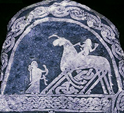History of Cooking
Part Two : Marmalade
by Nicky Saunders
| Marmalade is a food which has become associated with Scotland. It is made of a citrus fruit - usually oranges - cooked with sugar, and possibly other ingredients, to form a set jelly. Nowadays it is mainly served on bread, oatcakes or toast, or incorporated into desserts. The Romans discovered the process of making a jelly by heating and then cooling a combination of fruit acid and sugars which is used in all modern jams and marmalades. They traditionally preserved fruits in honey, but they found that quinces weren't suitable for being preserved in this way, so they precooked the quinces in wine before adding the honey. This caused pectin to be released and the mixture set to form a quince jelly. The Romans used this jelly as a medicine for indigestion and poor appetite. In Anglo Saxon times rosehips (and possibly other fruits) were preserved by being boiled down, with or without honey added, and stored in jars. The Anglo Saxons served meats with a variety of fruit sauces. Oranges and lemons were first shipped to the UK from Spain in the 13th Century, either as whole fruit, or as fruit and peel preserved in sugar syrup. Oranges were still used for medicinal purposes, and were believed to promote "good appetite" In the 15th Century, quince "marmelada" was imported from Portugal (see Portuguese Cooking for more details). By 1495 it was arriving in sufficient quantities to be assessed for Customs Duty in Britain. Marmelada was quite solid, so it was cut with a knife and served in slices as part of the final course of a feast. It was flavoured with rosewater and either musk or ambergris. Orange marmelade was also imported from Portugal. In 1608 the aphrodisiac properties of marmalades were being discussed. Queen Mary Tudor used a marmalade made of quinces, orange peel, sugar, almonds, rosewater, musk, ambergris, cinamon, cloves, ginger and mace to help her get pregnant. (It didn't work) Mary Queen of Scots is reputed to have used orange marmalade (sent from her childhood home in France) as a medicine. There is a story that the name "marmalade" is derived from the phrase 'Mary is ill (malade)' in French, but the name was in use long before Mary Queen of Scots was born. In the 1640s sugar from Barbados was becoming more widely available and it began to be used in more fruit conserves and other desserts. In the late 17th and 18th Centuries "marmalade madam" was a name for a prostitute. |




